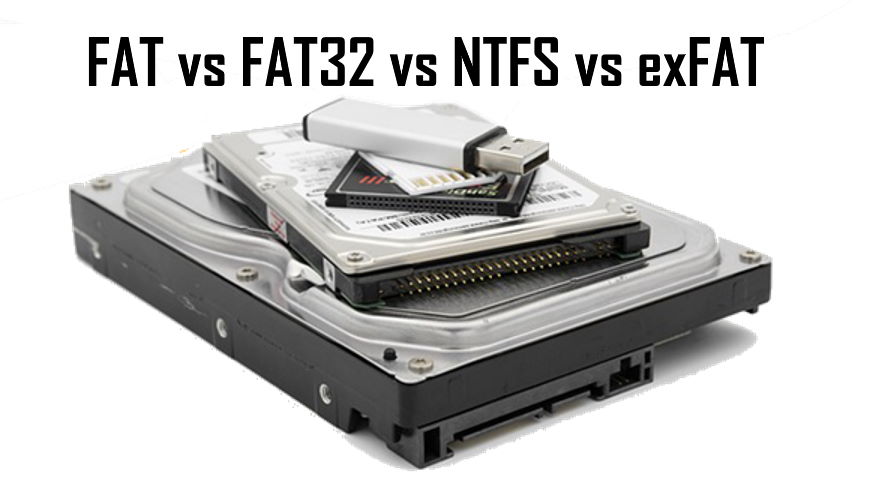A file system is the process and structure of keeping data on a storage medium, like a hard drive, DVD or USB stick.
In the beginning there was the F.A.T. (File Allocation Table) file system. FAT was created by Bill Gates in just 5 days in February 1976 and then later extended to work on floppy disks by the inventor of the Personal Computer, Commodore’s Chuck Peddle. FAT was replaced by a faster more capable versions including FAT16 and FAT32 but while FAT32 is functional on everything from Linux to Mac to Windows, it is old… really old.
exFAT (Extended File Allocation Table) and NTFS (New Technology File System) are both file systems used for storing and managing files on storage devices such as hard drives and flash drives.
Here is a comparison chart of the most common File Systems:
| FAT(8) | FAT12 | FAT16B+ | FAT32 | NTFS | exFAT | |
| Year Developed | 1976 | 1980 | 1984 | 1996 | 1993 | 2006 |
| Max Size of Single File | 8MB | 32MB | 4GB | 256GB | 16EB | 16EB |
| Max Volume Size | 32MB | 256MB | 4GB | 2TB | 8PB | 16EB |
| Max File Name Length | 6.3 | 8.3 | 8.3 | 8.3 | 255 | 255 |
| Max Sub Directories | 0 | 32 | 32 | 32 | 4.3B | 2.8M |
| Max Num of Files / Dir | 4K | 64 | 512 | 65K | 4.3B | 2.8m |
| Max Number of Files | 4K | 65K | 65K | 268M | 4.3B | 2.8M |
| Journaling | No | No | No | No | Yes | No |
| Encryption Support | No | Vol Only | Vol Only | Yes | Yes | Yes |
| Speed | Slowest | Slow | Slow | Faster | Very Fast | Fastest |
| Primary OS | DOS | DOS | Most OS’ | Most OS’ | Windows | Most OS’ |
What is ExFAT?
ExFAT is a newer file system that was developed by Microsoft in 2006 as a successor to FAT32 (File Allocation Table 32). It is designed for use with flash drives and other removable storage devices that have larger capacities than old FAT32 drives. ExFAT supports files larger than 4 GB and allows for a maximum file size of 128 PB (petabytes). ExFAT also has a faster file transfer rate than FAT32 and is more efficient in terms of disk space usage.
ExFAT was proprietary until 28 August 2019, when Microsoft made it public domain.
What is NTFS?
NTFS, on the other hand, is a more mature file system that was first introduced with Windows NT. It is the default file system for all Windows operating systems and is also supported by some Linux distributions. NTFS supports single file sizes up to 16 TB on volumes up to 8 Petabytes. It has advanced features such as file and folder permissions, disk compression, and support for hard links and symbolic links. NTFS also has built-in security features such as encryption and access control lists.
Is ExFAT Better Than NTFS?
In terms of compatibility, ExFAT is far more widely supported than NTFS. ExFAT can be read and written to by most modern operating systems, including Windows, Mac, and Linux. NTFS, on the other hand, is primarily used by Windows systems.
Because NTFS is a “Journaling” file system, it is much more powerful than exFAT, but it requires frequent recording of its logs during the read or write process. Flash Memory used in USB sticks and memory cards has a maximum of about 100,000 read / writes before it starts to degrade and become unreliable. So if you used NTFS on flash drives, and those drives were heavily used, the flash would have a much shorter lifespan compared to one formatted as ExFat. That being said, we use NTFS on USB sticks all the time and we think the vast majority of flash drive are not written to anywhere near their 100,000 time limit so NTFS is the best choice for nearly all USB stick / flash drive applications related Windows applications.
In terms of performance, NTFS is generally considered to be faster and more reliable than ExFAT, especially when working with large files or large numbers of files. NTFS also has built-in error checking and recovery features that can help prevent data loss in the event of a system failure.
In summary, ExFAT is a newer file system that is well-suited for use with flash drives and other removable storage devices, while NTFS is a more mature file system that is the default for Windows operating systems and offers advanced features such as file and folder permissions, disk compression and built-in security features. In terms of compatibility and performance, NTFS is generally considered to be the better option, but ExFAT is more widely supported.




2 Comments
Can’t Delete Files From SD Card? (5 Proven Ways) – Up & Running Technologies, Tech How To's · March 25, 2024 at 7:07 pm
[…] 4: You’ll be prompted to choose a file system (FAT32, exFAT, NTFS, etc.) and an allocation unit size. Typically, the default options are […]
SOLVED: Windows Green Screen Crash STOP CODE FAT_FILE_SYSTEM – Up & Running Technologies, Tech How To's · February 24, 2023 at 2:46 pm
[…] The problem our client had turned out to be caused by a memory stick that was plugged into a USB port. That makes a lot of sense because that was the only thing connected to the PC that had a FAT file system on it. If you’re interested to learn more about different file systems read our short article explaining the differences between FAT, FAT32, exFAT, and NTFS. […]